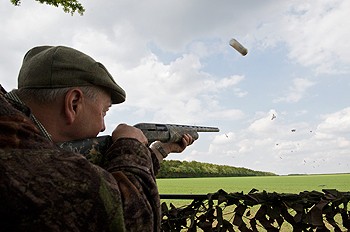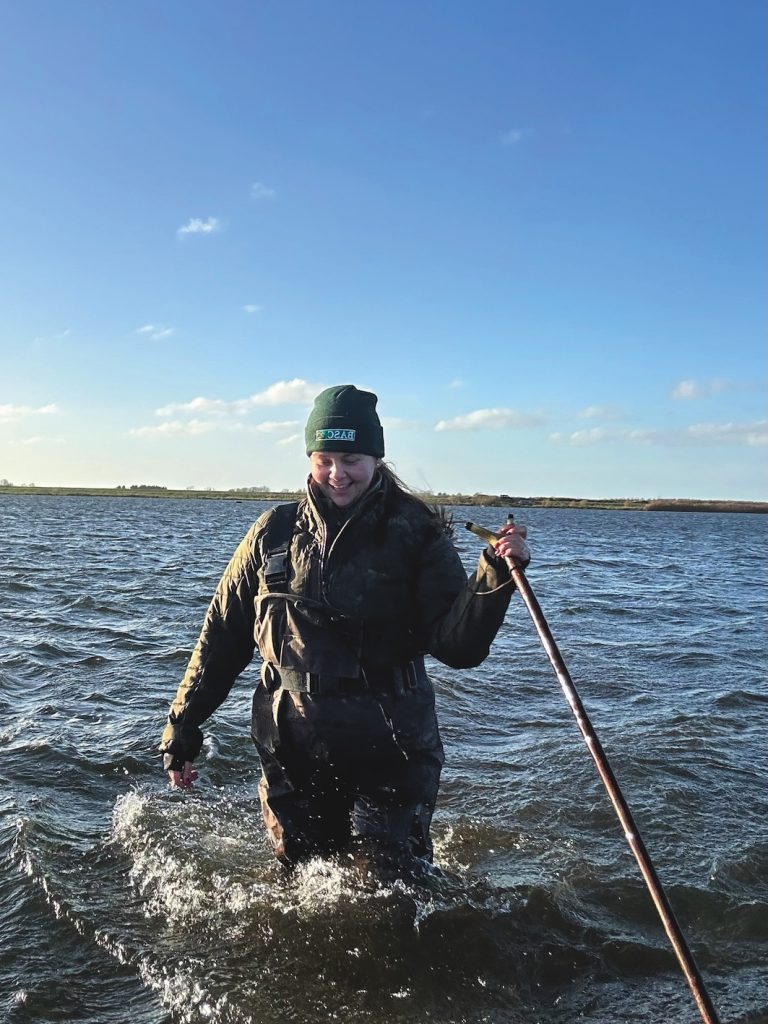Win CENS ProFlex DX5 earplugs worth £1,149 – enter here
Steel-shot pigeon
<strong>Joe Dimbleby joins hot-shot pigeon shooter Richard Gray in the hide on a Lincolnshire farm to get his tips for decoying woodies with steel shot</strong>

Much has been written about the inferior ballistics of steel shot, but former professional pigeon shooter and England clayshooter Richard Gray recently invited Shooting Times to his home in Lincolnshire to see how it performs in the field. Richards shooting credentials are hard to beat. A farmers son, he shot from childhood, eventually getting into clayshooting: I followed my father into it. Ive still got some of the prizes he won in the 1930s, a set of cake forks or a dozen soup dishes. No prize money then. Though the cash prizes these days are small by the standards of other sports, Richards won a lot of them. Hes shot competitively in all disciplines, he was Lincolnshire county champion on a number of occasions, a member of the England team, and one year finished eleventh in the world championship. His shooting talent transferred easily to live game, with an average kill of seven or eight out of 10 when out decoying. When I pushed him for details of his biggest bags, he told me that he once shot 118 with 122 cartridges, and that his record bag is 235.
Richard has been decoying at least once a week for the past 40 years and in the early 1970s he even went professional for a time. I remember the first day I shot 100 pigeon. At that time my wage was £28 a week. I got £40 for my bag and I thought this is for me. Later, he was dubbed the Lincolnshire pigeon gillie when he worked as a guide for several years. His love of shooting of all kinds probably cost Richard a job as loader/driver for Joseph Nickerson after being shortlisted to the last three. Joe shot 70 days of the season. Perhaps they wondered how Id fit in both the job and my own sport.
Steel shot for decoying
As we drove through the Lincolnshire countryside in brilliant sunshine, Richard explained that he decided to try steel shot two years ago after seeing an advertisement in a local paper wanting woodpigeon shot with non-lead cartridges for a nearby raptor breeding centre. The birds cant be shot with lead as one pellet is enough to kill a hawk or falcon, he said. I get 50p for the pigeon fresh or frozen. I bought a big old chest freezer and when Ive got 400 I ring them up. The falcon breeding centre has 200 breeding pairs, all of which go to rich Arabs in the Middle East. The birds are so valuable, fetching tens of thousands of pounds each, that they are flown first-class with a seat all to themselves.
Though he had a bad experience shooting duck with steel five years ago, Richard believes steel cartridges have come on hugely since then in terms of velocity and pattern. These days he uses 7.5 28g cartridges by Gamebore, which he regards as the market leader with very consistent hard-hitting loads. For Richard, if you are shooting birds at fairly close ranges, pattern beats penetration, but he would use No 5 shot on pigeon were it not for the cost (£3.50 a box as opposed to £5.50) as the penetration would be better and the pattern good due to the greater number of pellets in steel cartridges. The purest would say that you have to hit a vital organ to kill a bird, he said. I want to get a bird on the ground and if I can get multiple strikes it might not kill it but itll be dead pretty quick. The fact is that you dont kill as many birds stone dead with steel as you do with lead, so you have to stop yourself from taking longer shots. I dont shoot anything further than 30 yards. At the same time, anything closer is going to be well shot, especially with 7.5s. Richard doesnt use anything tighter than half-choke because of the increase in pressure with steel, but he doesnt find recoil an issue, though he thought it might be with an over-and-under.
Reconnaissance and permission
From the car things looked promising. We could see woodpigeon in large flocks landing on the arable fields all around us. Richard had been out scouting the day before an essential part of a successful days decoying. It helps if you start with a knowledge of what crop is growing where, he said. I had the first three or four fields of spring rape pencilled in for now, but it was not really up so I looked at the peas and winter rape. Next, you look for the corresponding flightlines. Many are well established, but they can move up to 500 yards either way depending on the wind and they wont use the same ones everyday.
As we approached the estate belonging to the Holsworth Trust where we were going to shoot, Richard explained that he has permission on 10,000 acres in the local area. Though hes had few problems obtaining permission, he knows of other shooters who are not so lucky but he believes it is down to approach. I dress smart-casual when I go round and make sure Ive had a shave. Im polite and I never ask them directly if I can go shooting. After introducing myself and saying where I live, I say something like: I was driving past and I noticed that youve got pigeon going down on those peas over there. I do a bit of pigeon shooting and I shoot on so-and-sos farm nearby. Would there be any chance I could come and have a go at decoying? Nine times out of 10 they say yes.
Setting and hide
After driving down a long track, we parked and walked to the hide. It was a stunning spot with the landscape stretched out in front of us and the tower of the Cranwell RAF college, on whose 90-year-old syndicate Richard has a half-gun, just visible in the distance behind. The hide was constructed from extendable aluminium sticks Richard had bought at a garden centre, plus two camouflage nets giving the important wide arc of fire. It was set under a solitary hawthorn looking over a pea field with a wood running along the left edge of the field. Richard explained its positioning: The beauty of an isolated spot like this is that they either come in or they dont. If you are under a wood, they might fly into the trees. I saw about 300 birds feeding here last night and theres a regular flightline from the wood behind us to the one on our right, which passes over the hide. As we have the sun behind us we dont need too much camouflage as they wont see us in the shade. If you are facing the sun they will see every movement, you have to keep down constantly and anything that shines will be picked up. If the birds are skirting wide of the pattern, its essential to walk out into the field to check your hide. I once discovered my lunch box was glinting in the sun and putting them off.
Pattern and shooting
Richard laid out the 15 frozen pigeon he had shot on a previous day in a circle about 20 yards from the hide with a flapper at one end facing into the wind. He later added a magnet. Sometimes a magnet is absolute dynamite pulling every pigeon from half a mile, other days it seems to frighten them away, he said. I made my first decoys out of some lino stapled together and painted grey, but I quickly realised dead birds were best. Once you have started shooting, keep putting your birds out. You have a huge draw if you get up to 80 birds. Richard opened the batting in style, shooting a single bird dead as it came in convincingly to the decoys. There followed several impressive double and triple shots as he put his Remington 11-87 Sportsman five-shot semi-auto to work. He frequently fires three or four shots at a time and has been known to shoot four out of a bunch. Occasionally I miss, but I expect to kill the first bird every time.
The steel cartridges brought down everything within 25 to 30 yards coming towards the hide, but there were a couple of occasions when a bird was well hit going away at about 30 yards and didnt come down straight away. It wasnt to be a Freddie Flintoff-style innings and though he hardly missed a bird in a highly impressive display of shooting, the lack of wind and Columba palumbus famous unpredictability meant that not much came over and the total bag was 22 rather than the 100 mark regularly reached by Richard. However, as Richard pointed out, much of the pleasure of decoying is being out in the fresh air and sunshine, watching the wildlife and doing not very much and there was plenty of that to enjoy.
Lead restrictions
Though Richard views steel as effective for medium-range decoying, he doesnt see it replacing lead and is opposed to restrictions on lead shot, believing a ban would hit poorer shooters who would never be able to afford Bismuth and that widespread use of steel would lead to wounding. For medium pheasants you need a hard-hitting cartridge and nothing but lead has that stopping power, he said. Its been proved that steel shot wounds more birds than lead, but I dont think the RSPB cares much about that. The RSPB sees it as a step in the right direction of their ultimate goal, which is to get shooting stopped. In Richards mind there is no scientific evidence for a ban. I dont know how ill I look (the answer is not very: hes 60 years old and shoots with the reactions of an 18-year-old), but I must have swallowed pounds of lead over the years. I remember shooting with an airgun when I was little youd put a dozen pellets in your mouth to carry. As a consequence, he feels shootings representative bodies should fight tooth and nail for the retention of lead. I want them to say that hell will freeze over before we submit to a ban on lead.
Related Articles
Get the latest news delivered direct to your door
Subscribe to Shooting Times & Country
Discover the ultimate companion for field sports enthusiasts with Shooting Times & Country Magazine, the UK’s leading weekly publication that has been at the forefront of shooting culture since 1882. Subscribers gain access to expert tips, comprehensive gear reviews, seasonal advice and a vibrant community of like-minded shooters.
Save on shop price when you subscribe with weekly issues featuring in-depth articles on gundog training, exclusive member offers and access to the digital back issue library. A Shooting Times & Country subscription is more than a magazine, don’t just read about the countryside; immerse yourself in its most authoritative and engaging publication.







